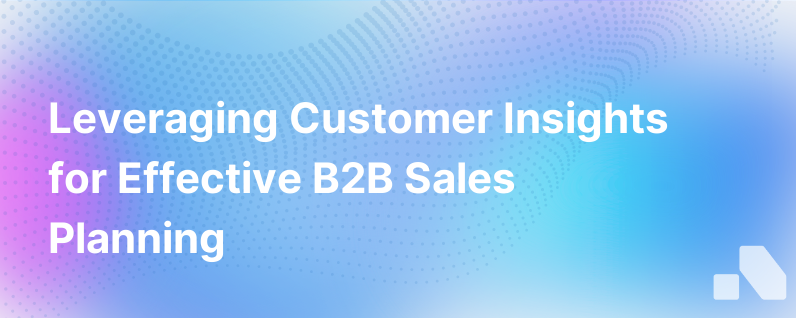
In the realm of B2B sales, the touchstone of success lies in the precise understanding of customer needs, goals, and pain points. Such wisdom is not gleaned through casual observation or intermittent communication but rather through the dedicated acquisition and analysis of customer insights. These insights have extraordinary implications for sales planning, contributing to tailored solutions, an optimized sales approach, and ultimately, enhanced profitability.
Sales strategies in the B2B sector traditionally relied on broad messaging and a standardized approach. However, the modern sales landscape has shifted, requiring companies to pivot away from a one-size-fits-all method in favor of targeted techniques shaped by robust customer intelligence. Here's a comprehensive exploration of the impactful role customer insights play in B2B sales planning.
The Essence of Customer Insights in B2B Sales
Within B2B sales, customer insights are essentially the crystal ball that enables sales teams to predict and respond to market needs with precision. By unraveling the layers of customer feedback, purchase behavior, and market trends, businesses can formulate strategies that are both persuasive and genuinely helpful to their target audience.
To wield these insights effectively, enterprises need to adopt a laser-focused approach—meticulously profiling their prospects, comprehensively documenting their journeys, and rigorously mapping their pain points. When such diligence in data collection and analysis is observed, customer insights become the lynchpin for the strategic planning of B2B sales, serving as a north star to guide all efforts for success.
How Customer Insights Transform B2B Sales Planning
Customer insights have a multifaceted impact on B2B sales planning, some of which include:
Tailored Messaging and Product Development
Armed with customer insights, sales and marketing teams can create highly targeted campaigns that speak directly to the pain points and aspirations of their prospects. This tailored messaging resonates more deeply, leading to higher engagement rates and conversion probabilities. Product development also benefits as customer feedback and usage data inform enhancements or new features that meet the evolving needs of the market.
Anticipated Needs and Customized Offers
Through predictive analytics, trends analysis, and voice-of-customer data, businesses can anticipate future client needs and curate personalized value propositions that preemptively address these requirements. In B2B sales, where solutions are often complex and the sales cycle long, being proactive is a definitive competitive edge.
Enhanced Relationship Building and Trust
Deep customer insights contribute significantly to building robust client relationships. When sales professionals demonstrate a clear understanding of a client's business and challenges, it builds trust and fosters a sense of partnership. Over time, this can translate into client loyalty and long-term contracts.
Optimized Sales Tactics
Insights into customer behavior and decision-making processes allow sales teams to fine-tune their tactics. For example, they might identify the best times to reach key decision-makers, the most effective channels for communication, or the types of content that drive the most engagement and conversion.
Improved Lead Nurturing and Conversion Rates
Understanding the customer’s journey allows for more effective lead nurturing strategies. By knowing where a prospect stands in the sales funnel and recognizing their content preferences and engagement patterns, sales teams can serve personalized experiences that guide prospects toward a closed deal with greater precision.
Best Practices for Utilizing Customer Insights in B2B Sales
To truly capitalize on customer insights in B2B sales, businesses should:
-
Continuously Gather and Analyze Data: Run an ongoing program to collect data through customer surveys, interviews, sales calls, and digital analytics. Employ AI and machine learning tools to draw actionable intelligence from this wealth of data.
-
Integrate Insights Across Departments: Foster inter-departmental collaborations where insights are shared between sales, marketing, product development, and customer service teams.
-
Apply a Dynamic Sales Strategy: Use insights to create dynamic, evolving sales plans that can readily adapt to new information or market shifts.
-
Invest in Training: Ensure your sales team is trained not only in the tactical aspects of sales but also in interpreting and applying customer insights.
-
Leverage Technological Tools: Utilize CRM tools and sales intelligence platforms like Aomni to automate and refine the process of collecting and employing customer insights.
Conclusion
The integration of customer insights into B2B sales planning is not merely an option but a necessity in the current competitive landscape. Forging a path to sales excellence is contingent on the profound understanding of clients that only meticulously gathered and skillfully applied insights can provide.
At Aomni, we respect the sanctity of quality customer insights in shaping strategic B2B sales. Our platform is designed to foster this profound connection between insights and action, providing sales teams with the tools they need to transform raw data into strategic genius. With Aomni, access real-time account research, actionable competitive insights, and personalized sales content—all essential components that leverage customer insights to chart a course towards more strategic, successful B2B sales.
Sources:
- Leveraging Customer Insights to Understand B2B Market Challenges
- B2B Customer Insights: What They Are and Why They Matter
- 5 Types of B2B Customer Insights for SaaS and How to Collect Them [+Best Tools]
- Customer Insights Can Seriously Elevate Your B2B Game
- An Ultimate Guide to Modeling Customer Insights in B2B
- The Power of Customer Insights in B2B SaaS – Unlock Your Competitive Edge 🚀
- How can customer insights improve your B2B media strategy?